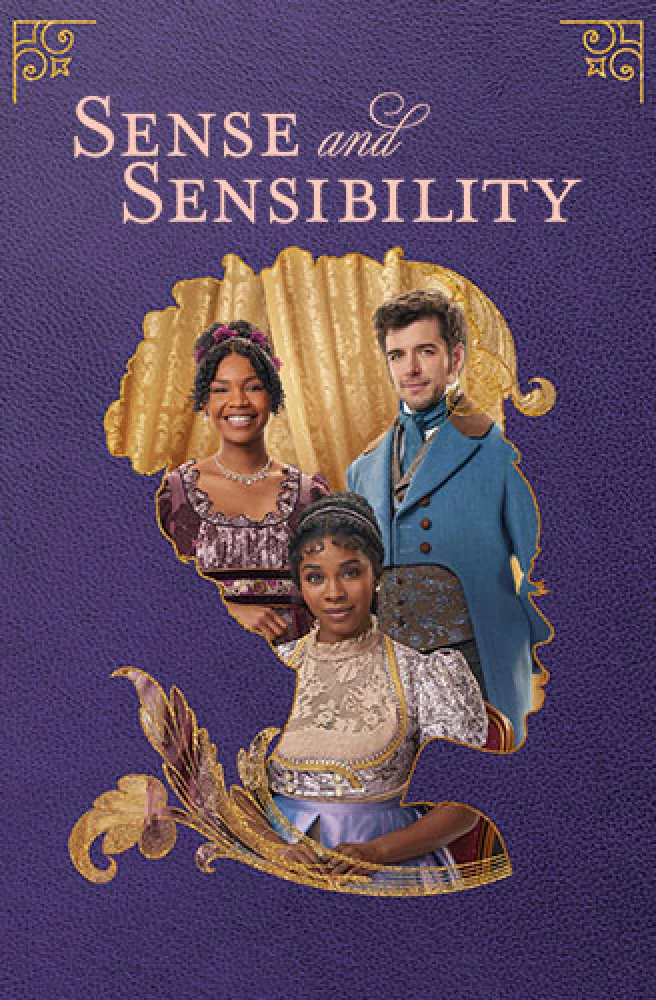
The end of Loveuary is upon us, and Hallmark’s final movie, Sense and Sensibility (SS), closes out our month of new Austen adaptations with a traditional period film set in the early 19th century and featuring all the things Janeites love to find in a film imitating Austen’s world: the clothing, the houses, the beautiful people, and–of course–the coupling.
There’s one more thing that this new adaptation gives us: color-conscious casting! Thanks to Netflix’s Bridgerton‘s popularity there are a lot of discussions of color-conscious casting on the internet and social media. The Tufts’ article linked above does a great job of explaining what color-conscious casting is, and it includes an interview with theater and performance professor Maurice Emmanuel Parent who defines color-conscious casting as “taking inventory of the bodies you’re putting in roles and just having awareness of what it means” and asks, “What are we evoking by putting this person with this particular racial background in this role?” For an Austen adaptation, we might ask what is the production evoking when Black people play some of the most famous characters to ever be written? The answer: equity, diversity, and inclusion.
While adaptations such as the 2022 Netflix Persuasion and the 2019 Lifetime Pride and Prejudice Atlanta have cast people of color as Austen characters, I don’t think we have seen Black actors portraying characters from SS. While Pride and Prejudice Atlanta was not set in 1813, the Netflix Persuasion was set in Austen’s time. Perhaps inspired by Bridgerton and Persuasion, SS offers a stunning view of how the nobility might have lived Regency England.
Hallmark’s SS is a part of the company’s Mahogony line of films that feature black actors. As Amanda-Rae Prescott explains, Hallmark’s Mahogony films not only feature black actors, but are written by Black screenwriters and showcase Black directors and “other creatives.” Prescott reminds us that “there have been many debates over the years as to whether Austen adaptations or Regency period dramas should acknowledge the existence of racism in the era or not.” Although series such as Bridgerton have addressed this, the fans of plots set in this historical time period need to think more about racial diversity and racism in early 19th century as well as in the 21st century. But they can also sit back for about an hour-and-a-half and enjoy a film that focuses on Black actors as Regency characters without calling explicit attention to such debates.
In Carol V. Bell‘s NPR article about the Loveuary films, SS’s creative producer, Tia A. Smith says the Hallmark movie set out to “respect the work [SS] and do something creatively refreshing.” Well, it certainly did that!
Let’s take these two goals and see how they hold up in the film.
1. Respect the work.
This SS adaptation sticks close to the content from the novel. While a few details are changed and, due to the nature of the medium, plot points are omitted, watching this movie made me feel like I was reading a graphic novel interpretation of the book. I say this with respect (I love graphic novels). The characters from Austen’s work came to life in new ways, but they still felt like Austen’s characters. I’m not the kind of fan who demands fidelity to the book, but sometimes it’s nice to watch an adaptation that resembles what I know and love about Austen’s novel.
2. Do something creatively refreshing.

At the fore of this creative and refreshing film is the casting and the way the film naturally places the actors in these roles without centering any racial divide. For instance, in the film’s opening scene we meet the Dashwood mother and daughters, who are played by Black actors, and not once did I question their race and whether or not these women belong in Norland Park. Mrs. Dashwood is married to Mr. Henry Dashwood, who is white and dies at the beginning of the film, and, as in the novel, her stepson, Mr. John Dashwood (whose mother was assumedly white), inherits his father’s estate. I didn’t feel like the film was trying to say John’s less than kind treatment of his stepsisters and mother was because of racism but because John is a man who is governed by a selfish wife, played by Carlyss Peer, who would never tolerate his stepsisters living at Norland and inheriting much money.
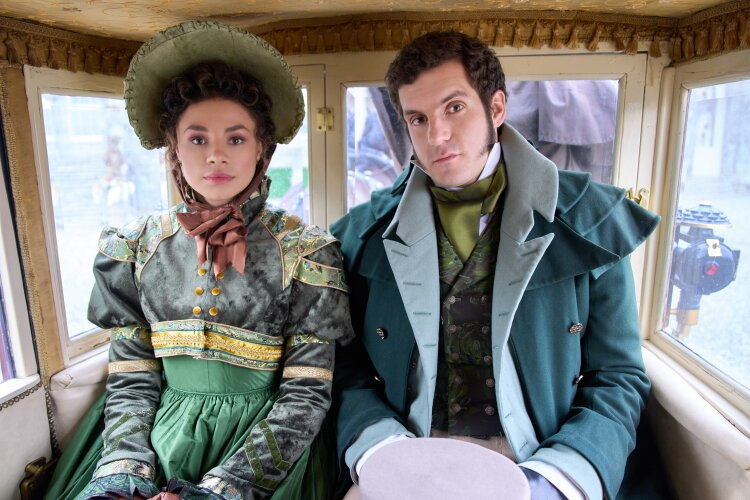
In fact, Fanny Dashwood ultimately convinces her husband to give his stepfamily a pittance, and they depart Norland for a smallish cottage because they are not welcome at their own longtime home. I love how awful Fanny is in Austen’s book and in this film. Peer did a good job of capturing Fanny’s character who as Edward Ferrars’ half-sister (in the novel there is no mention of this) also poses a threat to the Dashwood women’s happiness. Like her mother, Fanny is a snob and believes the Dashwoods are beneath Edward, whom they want to marry an heiress.

As in Austen’s book, Edward, played by Dan Jeannotte, falls for Elinor, though he is secretly engaged to Lucy Steele. Elinor’s and Lucy’s characters are played by Black actors Deborah Ayorinde and Victoria Ekanoye respectively. But there isn’t a moment where the viewer is meant to question why these Black women would be attracted to this white man (and vice versa) or why Marianne finds herself in a love with two Black men. It’s just the world of the novel-turned-film. This gives all of the actors in the production a chance to play Austen’s characters without the introduction of race as a complicating factor affecting how the characters interact with each other. In doing this, the movie opens the door for Black viewers to imagine themselves in the roles of Elinor, Marianne, Brandon, and Willoughby because they are finally given a film where its possible to be a main character who is Black and isn’t under scrutiny for being Black in Austen’s world. Further, it’s refreshing to see Black actors in starring roles instead of side characters (as in the Netflix Persuasion), or worse, servants.
This film is a tribute to Austen and Black History Month.
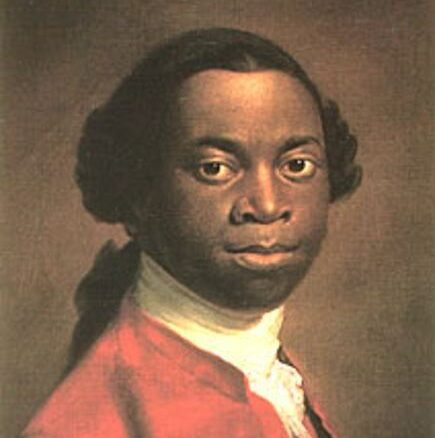
I was delighted to see the film subtly calling attention to famous Black people from the eighteenth and early nineteenth century. It does it in the background of the set and in references to writers including Phillis Wheatley and Olaudah Equiano. Wheatley is mentioned by Marianne as a favorite poet, and there’s a portrait of Equiano in Sir John Middleton’s house. (Note: Sir Middleton is a bachelor in this film though in the novel he has a wife and kids running around. Middleton is played by white actor Edward Bennett (another real life person named Bennett!!) in this movie, but we don’t get to see his family, which I assume are people of color because his mother-in-law Mrs. Jennings is a person of color. Again, the casting of is awesome. I enjoyed these two characters even though they didn’t get much screen time.
According to Prescott, the film’s historical consultant Vanessa Ridley has said of the Hallmark SS and the role of Black people in this production: “We don’t need to invent anything to explain our presence when the history is already there,” Riley said. This history shows up in a lot ways. For instance, Ridley says, “There’s a painting of one of the battles of the Haitian Revolution on the walls but it was sanitized onscreen because Hallmark doesn’t allow explicit violence. During the same time the Regency happens, Queen Louise and King Henri of Haiti are sitting on so much money that they say they have more cash on hand than the King of England. You can get the opulence you need just by introducing the real history, but the problem is most people don’t know real history.”
Prescott astutely notes that viewers of SS “will find quite a few historical Easter eggs in the artwork and also some portraiture of the actors if they look closely at the interior scenes.” One interesting change is to have African-American author Wheatley be Marianne and Willoughby’s favorite poet. In addition to Equiano’s picture at Barton Park we also see Dido Belle’s portrait (which is actually a small part of a large painting) in the dining room. There are lot of easter eggs, but I missed some. Thanks to Black Girl Loves Jane I learned that there was actually a pineapple in the background of one of the scenes. Ah, a Masterpiece Sanditon reference to #pineapplegate? Don’t know what I’m referring to? Read Damianne Candice Scott’s article about it.
Ultimately Prescott argues that Hallmark’s SS “will disrupt existing stereotypes within the fandom of what to expect from Hallmark productions while featuring familiar faces and style elements for longtime viewers,” but she wonders, “Will there be more predominantly-Black cast adaptations of other Austen novels or even other historical romances by Black authors?” There are directors and actors who want to see more adaptations, but, as Prescott rightly concludes, “the success of their future endeavors hinges on viewers embracing [the Hallmark] Sense and Sensibility.”
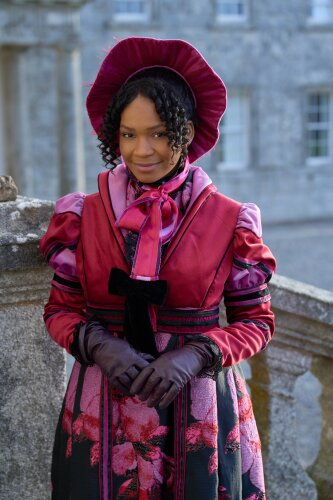
And there is a lot to embrace.
It’s now time for me to gush about the “creative, refreshing” costumes in this film. They are amazing. So bright and luxurious. I’ve never seen an adaptation use such interesting designs and colors. I was excited to learn from Prescott that costume designer Kara Saun–whom many of us know and love from Project Runway–created the costumes specifically to “complement varying skin tones.” Prescott also relates that hairdresser Kim Kimble “took into account Black hair textures” when she styled the gorgeous actors’ wigs and updos.

If I may offer one bit of a “whut?” let me draw your attention to one of Mrs. Dashwood’s hats, shown above, which seems too big! This made me feel like some of the costumes were mashups of Regency and Victorian styles. I’m not a purist, but sometimes I was finding myself going, is that a Regency fashion? {{shrug}} If they are drawing from both time periods I’m ok with that. It’s an impression not an exam.
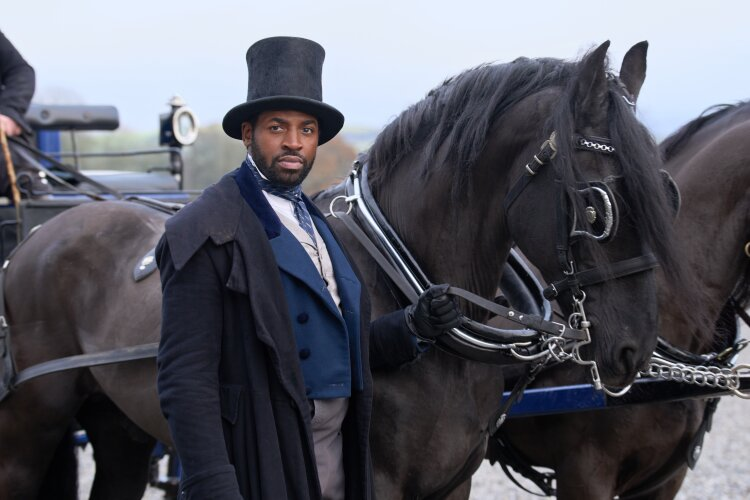
OK. Now it’s time to gush over Colonel Brandon, played by Akil Largie. When Brandon walks in the door of Sir John’s parlor I was like, wowza! He is hot hot hot. I mean, why wouldn’t Elinor or Marianne fall head over heels for this guy?
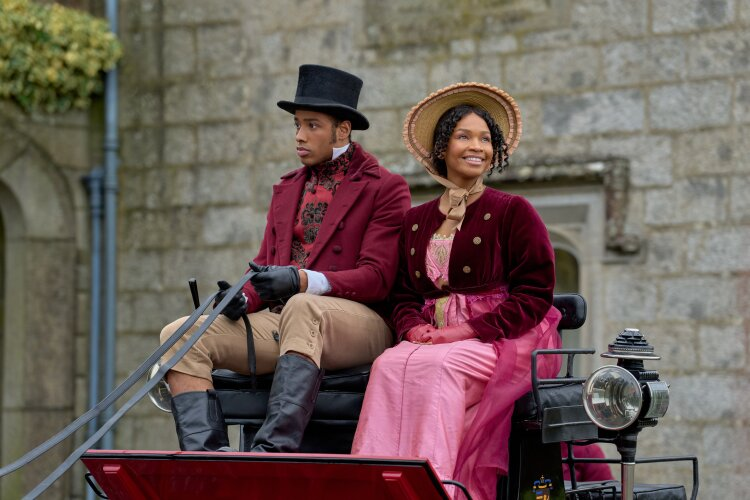
What about Willoughby? I’ll give him two hots and save my three for Brandon. Honestly, Marianne can’t go wrong if you’re just looking at these two gentlemen.
I’d drop Edward for Brandon if I were basing my decision on looks, but of course, we are still made to believe that Brandon is still a little too reserved. Unfortunately the film cut most of the mockery of Brandon we find in the book, so that made it really difficult for me as a viewer to find anything wrong with Brandon. He wasn’t said to be on the wrong side of five and thirty. He wasn’t made fun of for wearing flannel. No no no. He was just…um…not Willoughby and might have had a daughter out of wedlock (which turns out not to be true).
Brandon and Elinor are such a good match. Why wouldn’t she go for him over Edward, whom she believes loved Lucy Steele? This adaptation really plays on that. So many readers expect Elinor to end up with Brandon, but no she holds out for Edward. This adaptation makes me wonder even more. It’s interesting that this film portrays Brandon as a romantic man eventually. We don’t get that from the novel, but there are hints. This film says it directly thus making the viewer feel ok about Marianne marrying Brandon. In the novel, it still feels like she settles for marrying him. The film doesn’t talk about first attachments like the book does, so Marianne is absolutely free to move from Will to Brandon without a struggle and get her happy ending.
Ultimately, this film centered on the romance between Marianne and Brandon as Marianne says her affections lie elsewhere than with Willoughby when Brandon tells her Will could have had it all if he had been patient. The moment Brandon kisses Marianne is sweet, but it strays from the book. But Largie is so cute that I don’t mind. I like this version for Marianne as it gives her a much happier ending than the book does.
That said…although I enjoyed watching the film, especially being immersed in this gorgeous Regency world, I didn’t really feel the chemistry between the actors, and this is my disappointment with the movie. Elinor and Marianne didn’t feel close as they are in the novel, and in other adaptations I’ve seen.

Elinor and Edward had an ok groove, but Marianne and Willoughy and Marianne and Brandon didn’t do it for me. And this might have something to do with the way the actors played the parts, or maybe it was the direction the producer wanted to take. There was too much reserve and not enough excitement for me. I don’t know. I can’t quite put my finger on it, but there was something missing for me. {{shrugs again}}
I don’t want to end on a sour note, though. I’m gonna finish this blog post and my own Loveuary series posts by saying that new adaptations of Austen are welcome, and the fact that they were aired on a popular TV network and a streaming service (Peacock), means that people are going to watch these movies, and more than once. This keeps Austen alive in our pop culture, and it keeps revising and refreshing her plots and characters so that we keep revisiting them.
Regardless of whether or not you like a particular film or actor’s style, you gotta admit how fun it is to encounter something new in the Austenverse. And sometimes this brings fans together who celebrate Black actors playing Marianne and Elinor, and sometimes it divides fan who may see Austen, as Paging Mr. Darcy‘s Eloise does, as a comic genius, not a romance author, as opposed to those fans who, like Love & Jane’s Lilly, love Austenian romance because of the fantasy that love always wins and everyone gets their dream guy or girl in the end.
Or maybe we just need to sit back and think about, as Harriet from An American in Austen does, how things are supposed to turn out vs. how they actually do. This might also be a lesson for the Austen fan. We might think we know how it all goes, but sometimes there are plot twists and things go awry. As long as we can take a step back and go, ok, how can I fix this and believe in ourselves, things should be OK. But we have to show up and step up, as Harriet does. As Eloise does. As Elinor does.
Thanks, Austen, for giving us characters that inspire other characters and inspire us to be the best versions of ourselves.
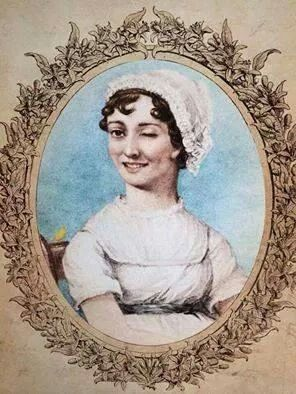
Leave a comment